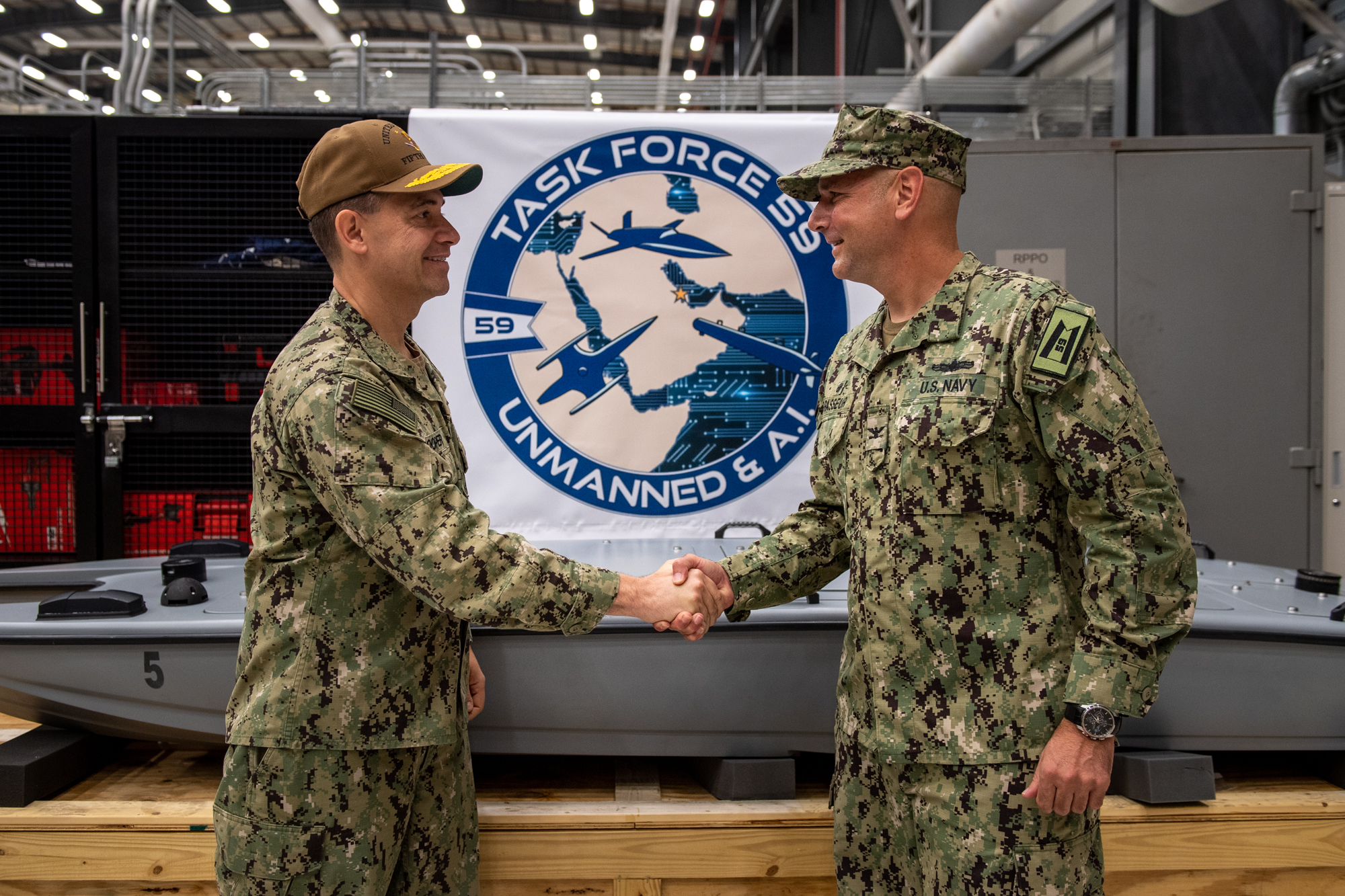In early September 2021, the U.S. Navy set up a new task force to deliver usable unmanned systems for enhanced maritime capabilities in the 5th Fleet Area of Operations.
In a story written by MC1 Roland Franklin and published on September 9, 2021 by the U.S. Navy:
U.S. Naval Forces Central Command (NAVCENT) established a new task force, Sept. 9, to rapidly integrate unmanned systems and artificial intelligence with maritime operations in the 5th Fleet area of operations.
Task Force 59 is the first U.S. Navy task force of its kind.
The U.S. 5th Fleet region’s unique geography, climate, and strategic importance offer an ideal environment for innovation.
“The bottom line on why we’re doing this is so that we can develop and integrate unmanned systems and AI as a means to do two things,” said Vice Adm. Brad Cooper, commander of NAVCENT, U.S. 5th Fleet and Combined Maritime Forces. “One, enhance our maritime domain awareness, and two, increase deterrence.”
Cooper also stated the task force would rely heavily on regional and coalition partnerships.
“The launch of Task Force 59 really invigorates our partnerships around this region as we expand our common operating picture.”
Cooper appointed Capt. Michael D. Brasseur, an expert in maritime robotics, as Task Force 59’s first commodore during a commissioning ceremony onboard Naval Support Activity Bahrain, Thursday. Brasseur served as a founding member of the NATO Maritime Unmanned Systems Initiative prior to arriving in Bahrain.
“It’s an honor to be named commander of this historic and innovative task force,” said Brasseur. “As we continue to adapt and implement cutting edge technology, I fully expect our talented team will enrich and enhance the 5th Fleet mission.”
Brasseur’s staff includes experienced operators with region-specific expertise, including directors for unmanned systems; unmanned exercises; task force integration; cyber, AI and space; and partnership opportunities.
In the coming weeks, the task force aims to build trust and confidence in human-machine teaming through a series of operations at sea. International Maritime Exercise (IMX) 22, slated for next year, will provide NAVCENT a real-world opportunity to demonstrate the resiliency and scalability of human-machine teaming technologies.
IMX-22 will include more than 60 nations and international organizations and features the extensive use of unmanned systems in various operational scenarios designed to challenge the technology in a dynamic environment and ultimately enhance partner capabilities through manned and unmanned teaming.
The U.S. 5th Fleet area of operations encompasses nearly 2.5 million square miles of water area and includes the Arabian Gulf, Gulf of Oman, Red Sea and parts of the Indian Ocean. The region is comprised of 21 countries and includes three critical choke points at the Strait of Hormuz, the Suez Canal and the Strait of Bab-al-Mandeb at the southern tip of Yemen.
And in in a story written by John. W. Miller and Ari Cicurel published on October 6, 2021, this is how the Task Force’s role was explained:
“By increasing the Fifth Fleet’s unmanned operations in the Middle East, TF-59 will realize more persistent and capable intelligence coverage and more capacity to deter, detect, prevent, and respond to Iranian maritime aggression than conventional manned platforms currently produce.
“Incorporating surveillance and attack unmanned platforms above, on, and under the sea into a sensor network will provide earlier warning of Iranian intentions and attacks, further enabling a secure maritime environment throughout the region. The persistence of unmanned vehicles serves as a force multiplier at a time when America needs to repurpose manned ships and aircraft in support of emerging national.”
The authors noted: “TF- 59 will have unmanned platforms, such as the unmanned surface vehicles Sea Hunter and Seahawk, the MQ-9B Sea Guardian, and the MQ-8B Fire Scout autonomous helicopter.”
But notably,. the Task Force featured in a recent video the “little engine that could” as a key capability they were exercising now, the MANTAS T-12 which is part of a family of USVs avaialbe right now for the U.S. and allied Navies.
According to the Command:
“MANTAS T-12 unmanned surface vessels operating in the Arabian Gulf alongside U.S. Navy crewed assets.
“This was the first unmanned/manned teaming activity underway for U.S. 5th Fleet’s new Task Force 59. The task force was established Sept. 9 to accelerate the development and integration of new unmanned systems across the fleet.”
10.20.2021
Video by Sgt. Thiem Huynh
U.S. Naval Forces Central Command / U.S. 5th Fleet
The featured photo: Vice Adm. Brad Cooper, left, commander of U.S. Naval Forces Central Command, U.S. 5th Fleet and Combined Maritime Forces, shakes hands with Capt. Michael D. Brasseur, the first commodore of Task Force (TF 59) during a commissioning ceremony for TF 59 onboard Naval Support Activity Bahrain, Sept. 9. TF 59 is the first U.S. Navy task force of its kind, designed to rapidly integrate unmanned systems and artificial intelligence with maritime operations in the U.S. 5th Fleet area of operations. (Photo by Mass Communication Specialist 2nd Class Dawson Roth).
Also, see the following:
https://defense.info/system-type/martac-maritime-autonomous-systems/


